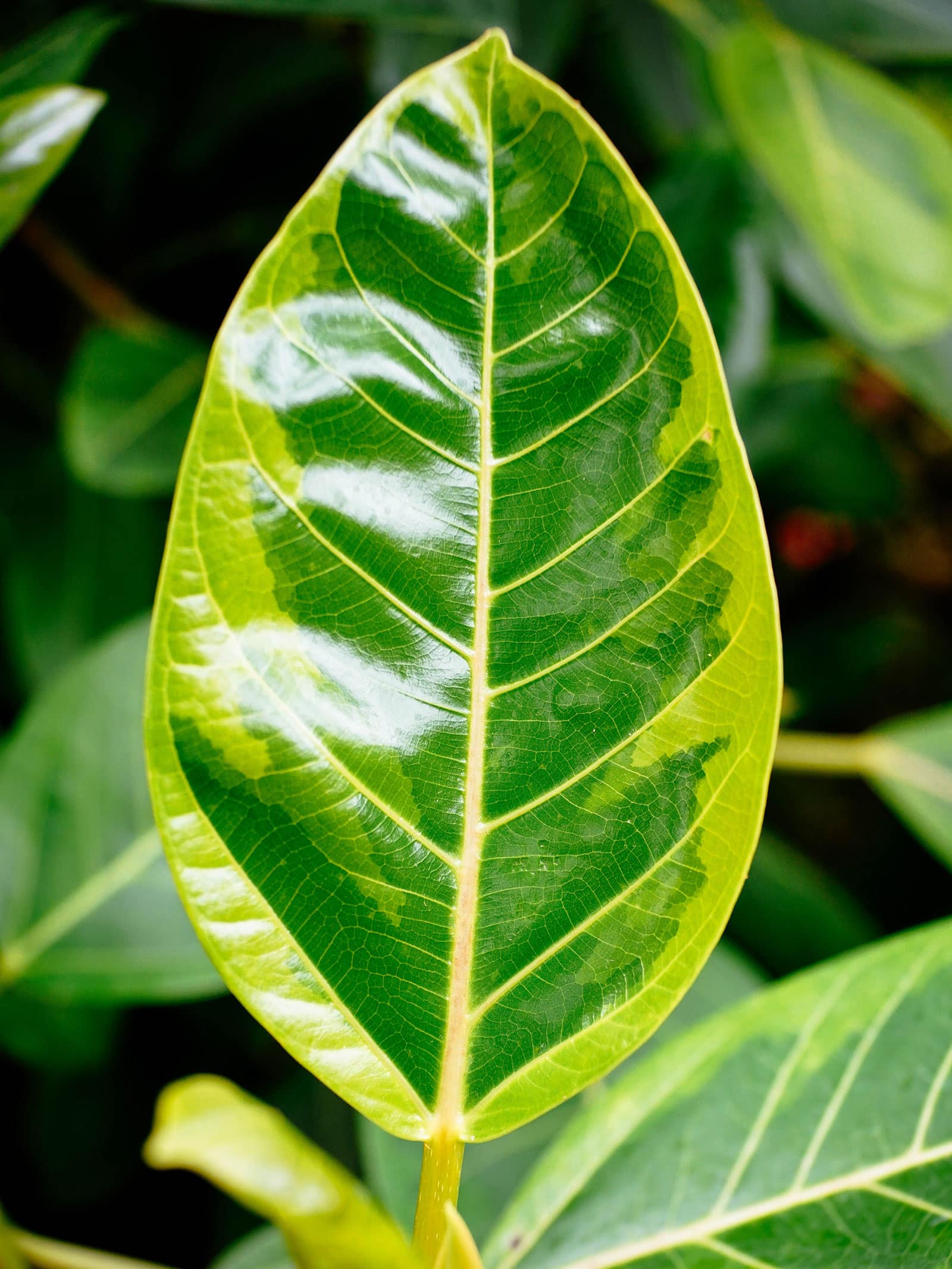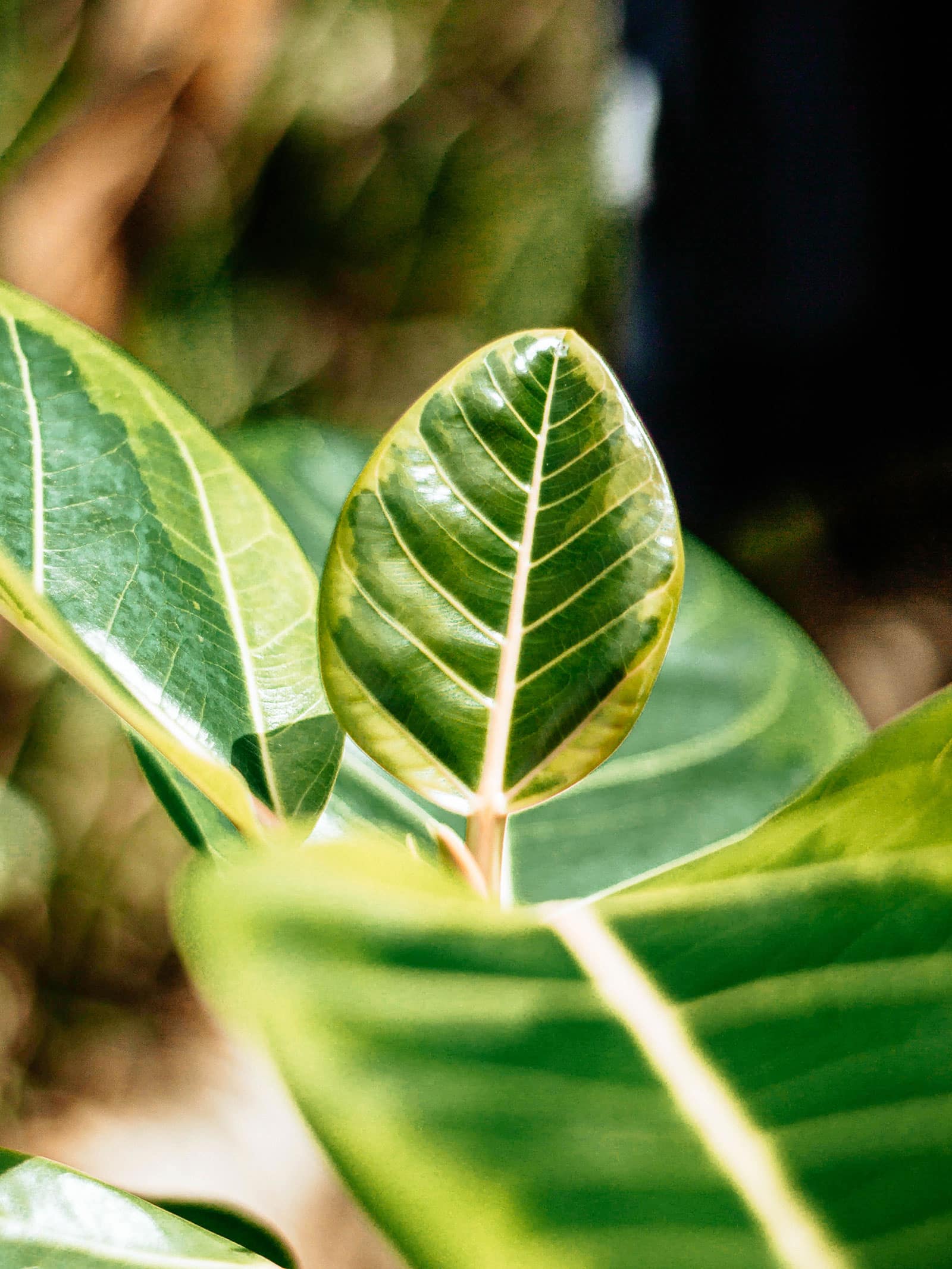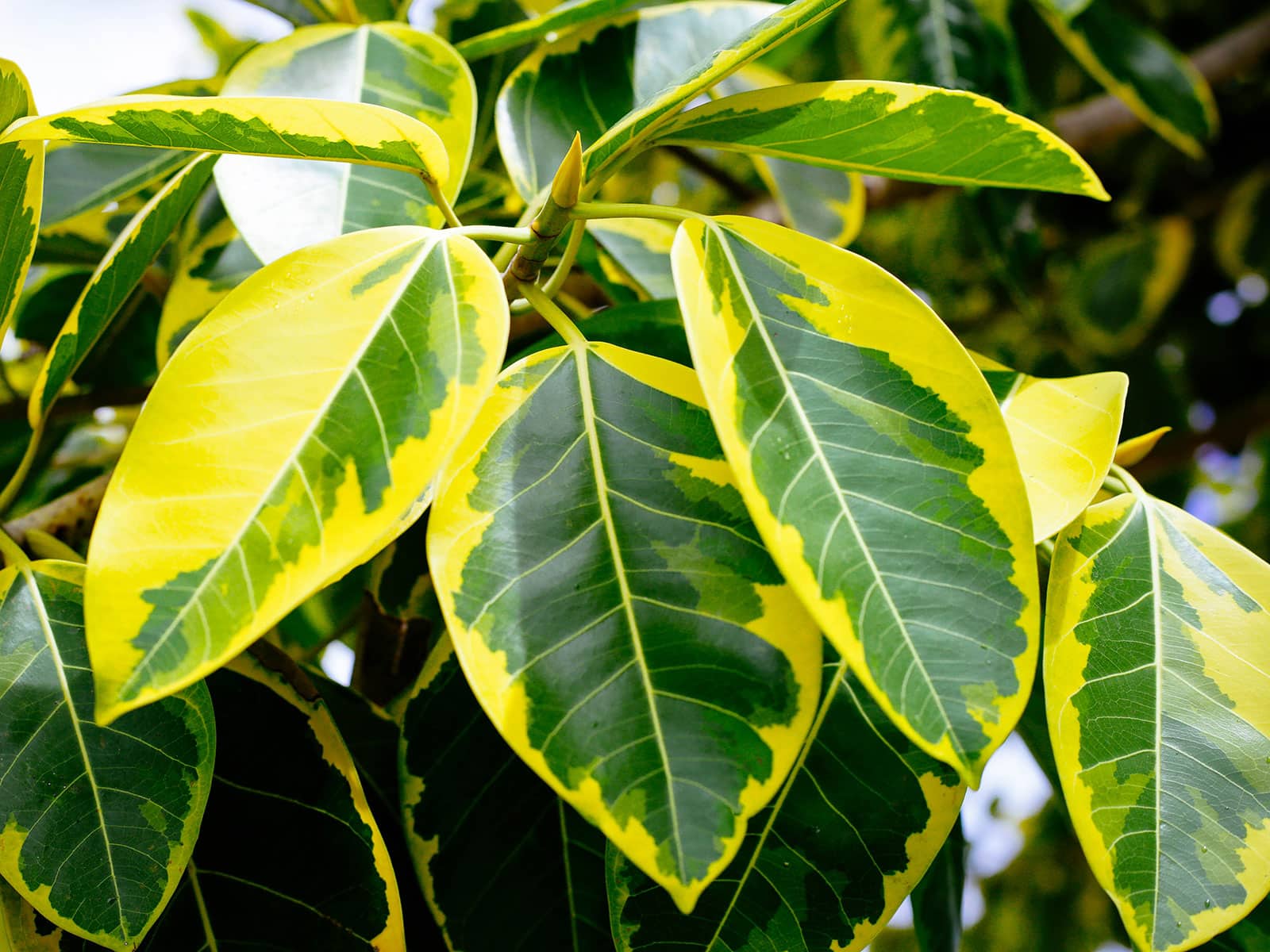If you’re looking for a large, elegant houseplant that’s a statement piece, you can’t go wrong with the genus Ficus. Although these trees are capable of reaching immense sizes in the wild, they usually don’t surpass 10 feet in height in our homes. One of my favorites is Ficus altissima (which you may have heard referred to as a council tree), a species naturally found in Southeast Asia.
Here’s everything you need to know about the council tree, its care requirements, and how to make sure yours thrives in your home!
| Common name(s) | Council tree, lofty fig, false banyan |
| Scientific name | Ficus altissima |
| Family | Moraceae |
| Height & spread | Up to 10 feet high and 3 feet wide (indoors) |
| Light | Full sun |
| Soil type | Well-draining |
| Water | Let the soil dry halfway |
Disclosure: If you shop from my article or make a purchase through one of my links, I may receive commissions on some of the products I recommend.

About Ficus altissima
Description
Ficus altissima is an evergreen tree boasting thick, oval leaves in shades of dark green, with a lighter vein running through the middle. Its foliage has been described as looking almost “plasticky” (but in a good way!).
The young plants you’ll find for sale in your local plant store usually have a single trunk with some aerial roots, but mature Ficus altissima trees in the wild can be multi-stemmed. They have thick air roots that reach all the way down to the ground, and their stems sometimes take on an almost latticed appearance.
Did you know?
In the wild, Ficus trees like this one are pollinated by specific species of wasps. In this case, the (tiny) wasp pollinator is named after its host: Eupristina altissima.
Natural habitat
Like most of the Ficus species we grow as houseplants, F. altissima is naturally found in Asia. It was first described in 1826 from Java, but can actually be found in large parts of Southeast Asia: Thailand, Vietnam, Laos, and more.

Ficus altissima forms part of a Ficus subgenus called Urostigma. Its members are also known as banyans or strangler figs. They’re characterized by the fact that they start out their lives growing on other trees, often without any direct contact with the ground.
Many plants are capable of growing on other plants (usually trees) without affecting their host negatively. (You see this happening with epiphytes like Monstera deliciosa, Syngonium podophyllum, Hoya carnosa, and Peperomia prostrata.)
But—Ficus altissima is not one of these! It uses its victim as a support, wrapping itself around the trunk until it’s large enough to continue life independently. By this time, the original tree will often have been almost completely covered, and it will generally die due to a lack of light and nutrients.
It’s a rather aggressive lifestyle for a species that’s closely related to the ubiquitous fig tree with its delicious fruits! Luckily, in the home, there’s no need to sacrifice any innocent plants in order for your Ficus altissima to grow.
Did you know?
Ficus altissima is sometimes used as a landscaping tree, although it’s not really suitable for cities. Its very large root systems can eventually damage buildings and infrastructure. Unfortunately it’s now considered an invasive species in some places, like parts of Florida.
Ficus altissima varieties
If you’d like to add a Ficus altissima to your houseplant collection, you can choose between wild-type (green leaves) and variegated (marbled leaves) versions.
I’ve seen the variegated cultivars being referred to as both ‘Golden Gem’ and ‘Yellow Gem’, but I’m pretty sure they’re one and the same.

Where to buy
Ficus altissima trees
Caring for Ficus altissima
Light and temperature
Houseplant enthusiasts sometimes struggle to keep their Ficus trees alive, and a lot of this appears to be a result of confusion about light. Ficus altissima, like many of its cousins, is often recommended for spots in the home that receive bright indirect light.
But think about it: In the wild, these tall trees are blasted by the tropical sun on a daily basis. They haven’t evolved to make do with low light levels!
So, I strongly recommend placing your Ficus right in front of the sunniest window you can offer. A plant that receives enough light will be much more resilient, as well as more forgiving of mistakes in watering.
In most regions, a Ficus altissima can even be placed outdoors during the summer months, allowing it to soak up as much sun as possible. Make sure to acclimate your tree over the course of a few weeks, because a plant moved from an indoor space right into the summer sun can end up with leaf burn.
As for temperature, this is a tropical, so it’s not used to cold. Room temperature and up are perfect. If you feel comfortable in your home, then your plant should be fine as well.
A Ficus altissima grown outdoors during the warm months should be taken back inside when night temperatures reach around 60°F. Any colder and the tree can start dropping its leaves.
Soil and planting
Like most tropical houseplants, Ficus altissima likes its soil lightly moist at all times. However, it really doesn’t tolerate sogginess! The right soil mixture holds a small amount of water, but allows excess moisture to drain easily in order to prevent root rot from setting in.
Normal, high-quality houseplant soil with a few handfuls of added perlite should work fine for this species. If you feel like the soil dries too quickly, you could add a little sphagnum moss. For soil that stays wet too long, a cup of orchid bark may prove helpful.
As for potting, a Ficus altissima doesn’t care about the container type as long as there’s a hole in the bottom. I personally recommend a relatively wide planter for larger specimens, as they can be prone to falling over in narrower ones.
Recommended products for Ficus altissima plant care:
- Good Earth Organics Premium Potting Soil
- Perfect Plants Organic Perlite
- Better-Gro Orchid Moss
- Better-Gro Orchid Bark
Water and humidity
As mentioned, Ficus altissima likes its soil (very) lightly moist, but is intolerant to its feet staying wet for extended periods of time. So, it’s best to avoid watering on a regular weekly schedule. Instead, stick a finger into the soil to gauge the moisture level before watering. This way, you’ll know whether your plant is actually thirsty or not quite in need of a drink yet.
You can water once half the soil feels dry. If it’s still damp, it’s best to wait another day or two. And don’t forget that our houseplants usually need a lot less water during winter than during the warm and bright summer months!
Fertilizing
Ficus altissima likes a little fertilizer during the growing season (spring to late summer). You can apply a balanced liquid houseplant fertilizer once or twice a month according to the instructions on the bottle.
Recommended fertilizers for Ficus altissima:
- Elm Dirt Plant Juice Organic Fertilizer
- Houseplant Resource Center Liquid Fertilizer for Houseplants
- Bless Your Soil Fiddle Leaf Treats Indoor Plant Food
Pruning
Indoor trees like this one don’t need to be pruned regularly in order to grow properly. You can prune yours if you feel the branches have grown out of control, but it’s not a must.
It’s normal for a healthy houseplant to slowly shed its bottom leaves as it grows new ones on top. You can remove any dead leaves on your Ficus altissima once they’ve crisped up, meaning the plant has reabsorbed all the nutrients it can from them.
Dividing or repotting
Like other types of indoor trees, Ficus altissima doesn’t tend to produce offshoots, so it’s not really a suitable candidate for division (although you can propagate it—see the next section below).
Instead, it’s best to repot your plant every other year or so. You can do so during springtime, right at the start of the growing season. If your Ficus has outgrown its current planter, you can go one pot size up. If it still has plenty of space, then just changing out the soil is fine.

Propagating Ficus altissima
Propagation: a fancy word for creating new houseplants for free! Although propagating woody plants like Ficus trees can be a little more challenging than with soft-stemmed species (they’re definitely slower to root), it’s still possible to multiply yours at home.
Taking cuttings from the branch tips gives you the best chances of propagation success. Use clean pruning shears to remove a cutting measuring at least 4 to 5 inches, preferably with a few leaves.
Once you’ve obtained your cutting, you can propagate in water or soil. For water propagation, place the stem in a small vase or glass of water and set it in front of a window that doesn’t get direct sun. The first roots should appear within a few weeks. You can move the cutting to soil once the root system measures around 2 inches in length.
If you prefer propagating directly in soil, I highly recommend dipping the cutting in some rooting powder before sticking it into a Ficus-appropriate medium. Place the container with your cutting in a warm and light spot and be patient; it can take a few months for the cutting to root and the first new leaves to appear.
For larger cuttings, it may be useful to look into a propagation method called air layering. It increases the chances of success with the woodier parts of a plant.
Is Ficus altissima toxic to cats and dogs?
This plant is lightly toxic. If your pet ingests it, the white, latex-like sap present in the leaves, stems, and roots can cause gastrointestinal upset (vomiting, diarrhea) as well as irritation to the mouth and mucus membranes.
It’s best to keep Ficus altissima out of your pet’s reach. If it does manage to take a bite, offer plenty of water and stay vigilant for the next 24 hours. If you’re worried, consider ringing your veterinarian to ask about the best course of action, but serious issues are pretty much unheard of.
Sources:
- https://powo.science.kew.org/taxon/urn:lsid:ipni.org:names:852369-1
- Peng, Y. Q., Duan, Z. B., Yang, D. R., & Rasplus, J. Y. (2008). Co-occurrence of two Eupristina species on Ficus altissima in Xishuangbanna, SW China. Symbiosis.















